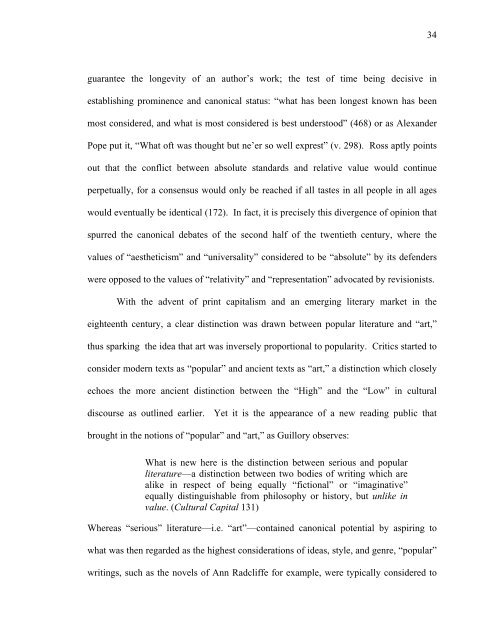Untitled - Sexey's School Moodle
Untitled - Sexey's School Moodle
Untitled - Sexey's School Moodle
Create successful ePaper yourself
Turn your PDF publications into a flip-book with our unique Google optimized e-Paper software.
guarantee the longevity of an author’s work; the test of time being decisive in<br />
establishing prominence and canonical status: “what has been longest known has been<br />
most considered, and what is most considered is best understood” (468) or as Alexander<br />
Pope put it, “What oft was thought but ne’er so well exprest” (v. 298). Ross aptly points<br />
out that the conflict between absolute standards and relative value would continue<br />
perpetually, for a consensus would only be reached if all tastes in all people in all ages<br />
would eventually be identical (172). In fact, it is precisely this divergence of opinion that<br />
spurred the canonical debates of the second half of the twentieth century, where the<br />
values of “aestheticism” and “universality” considered to be “absolute” by its defenders<br />
were opposed to the values of “relativity” and “representation” advocated by revisionists.<br />
With the advent of print capitalism and an emerging literary market in the<br />
eighteenth century, a clear distinction was drawn between popular literature and “art,”<br />
thus sparking the idea that art was inversely proportional to popularity. Critics started to<br />
consider modern texts as “popular” and ancient texts as “art,” a distinction which closely<br />
echoes the more ancient distinction between the “High” and the “Low” in cultural<br />
discourse as outlined earlier. Yet it is the appearance of a new reading public that<br />
brought in the notions of “popular” and “art,” as Guillory observes:<br />
What is new here is the distinction between serious and popular<br />
literature—a distinction between two bodies of writing which are<br />
alike in respect of being equally “fictional” or “imaginative”<br />
equally distinguishable from philosophy or history, but unlike in<br />
value. (Cultural Capital 131)<br />
Whereas “serious” literature—i.e. “art”—contained canonical potential by aspiring to<br />
what was then regarded as the highest considerations of ideas, style, and genre, “popular”<br />
writings, such as the novels of Ann Radcliffe for example, were typically considered to<br />
34



